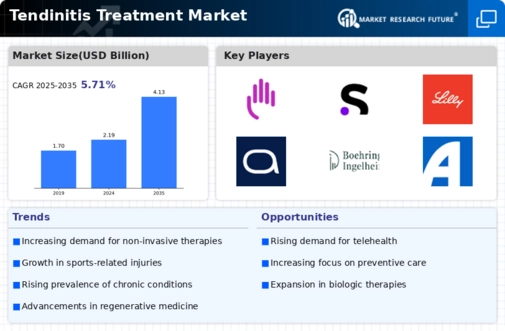Rising Healthcare Expenditure
The upward trend in healthcare expenditure is a significant driver for the Tendinitis Treatment Market Industry. As countries allocate more resources to healthcare, there is an increased focus on providing comprehensive treatment options for various conditions, including tendinitis. This financial commitment enables healthcare systems to invest in advanced treatment technologies and therapies, thereby enhancing patient access to effective care. Additionally, higher healthcare spending often correlates with improved health outcomes, as patients are more likely to receive timely and appropriate interventions. Consequently, this trend is expected to bolster the growth of the Tendinitis Treatment Market Industry as more individuals seek treatment for their conditions.
Growing Awareness of Preventive Care
There is a notable shift towards preventive care in the Tendinitis Treatment Market Industry, driven by increasing awareness among patients and healthcare providers. Educational initiatives aimed at promoting healthy lifestyles and injury prevention strategies are becoming more prevalent. This focus on prevention is likely to reduce the incidence of tendinitis, thereby influencing the demand for treatment options. Moreover, as individuals become more proactive about their health, they are seeking out therapies that not only address existing conditions but also prevent future occurrences. This trend is expected to shape the market dynamics, as providers adapt their offerings to meet the evolving needs of health-conscious consumers.
Rising Incidence of Tendinitis Cases
The increasing prevalence of tendinitis cases is a primary driver for the Tendinitis Treatment Market Industry. Factors such as aging populations and sedentary lifestyles contribute to a higher incidence of musculoskeletal disorders, including tendinitis. According to health statistics, the number of individuals affected by tendinitis has been steadily rising, with estimates suggesting that millions are diagnosed annually. This growing patient population necessitates effective treatment options, thereby propelling the demand for various therapeutic modalities within the Tendinitis Treatment Market Industry. As healthcare providers seek to address this rising burden, the market is likely to witness an influx of innovative treatment solutions aimed at alleviating symptoms and improving patient outcomes.
Advancements in Treatment Technologies
Technological advancements in treatment modalities are significantly influencing the Tendinitis Treatment Market Industry. Innovations such as regenerative medicine, including platelet-rich plasma (PRP) therapy and stem cell treatments, are gaining traction as effective alternatives to traditional therapies. These cutting-edge approaches have shown promise in enhancing healing processes and reducing recovery times for patients suffering from tendinitis. Furthermore, the integration of minimally invasive surgical techniques is transforming the landscape of treatment options available. As these technologies continue to evolve, they are expected to drive market growth by offering patients more effective and less invasive solutions for managing tendinitis.
Increased Participation in Sports and Physical Activities
The growing participation in sports and physical activities is a notable driver for the Tendinitis Treatment Market Industry. As more individuals engage in recreational and competitive sports, the incidence of sports-related injuries, including tendinitis, is likely to rise. This trend is particularly evident among younger populations, who are increasingly involved in various athletic pursuits. Consequently, the demand for effective treatment options to address these injuries is expected to grow. Sports organizations and healthcare providers are recognizing the need for specialized treatment protocols to manage tendinitis effectively, thereby contributing to the expansion of the Tendinitis Treatment Market Industry.



















Leave a Comment